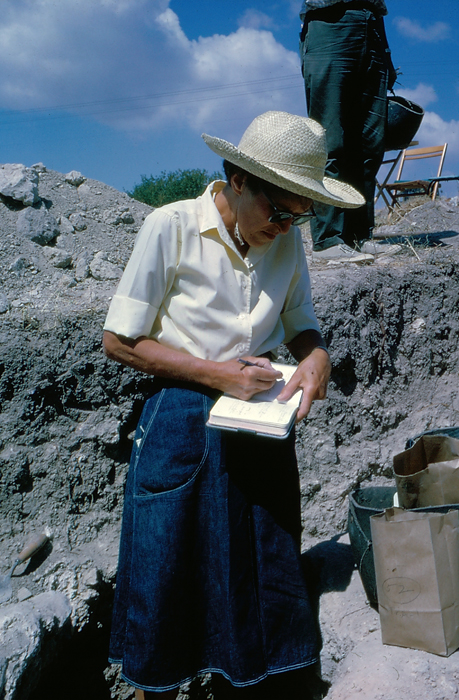By Sarah Thomson
Registrar and Collections Manager

Gladys Weinberg, PhD, excavating a glass factory in Jalame, Israel, in the late 1960s.
What is the connection between Gladys Weinberg, PhD, one of the founders of the Museum of Art & Archaeology (MA&A), and Indiana Jones?
In the new movie, “Indiana Jones and the Dial of Destiny,” Indiana Jones chases after the Archimedes Dial, a device from antiquity that allows the user to (spoiler alert) travel through time. The Archimedes Dial is based on a real artifact called the Antikythera mechanism, an ancient device discovered in 1900 inside a Roman-era shipwreck off the coast of the Greek island of Antikythera.
The real Antikythera mechanism can’t find fissures in time, but it is an incredibly advanced piece of technology. It used complex gears and dials to display information about astronomical events and track the movements of the sun and moon. The device dates to around 200 – 60 BCE based on the dates of coins and amphoras also found in the shipwreck.
Weinberg, an ancient glass specialist and MA&A’s legendary co-founder, first curator of ancient art, and eventually assistant director, studied eleven glass artifacts recovered from the Antikythera shipwreck that helped her define the chronology of Hellenistic glass. In 1965 she wrote, “They form a most interesting and valuable group, and with the date of 65 B.C. +/- fifteen years which can be attributed to them by virtue of the associated objects, they constitute an important fixed point in our knowledge of the development of ancient glass.” Thus, through a multidisciplinary analysis she and her co-authors were able to narrow down the date of the Antikythera shipwreck to 80 – 50 BCE.
Learn more about Indiana Jones and the Antikythera mechanism in this article from "Smithsonian Magazine."
Sources
“The Glass Vessels from the Antikythera Wreck,” in G. D. Weinberg et al., “The Antikythera Shipwreck Reconsidered,” Transactions of the American Philosophical Society 55.3 (1965) pp. 3–4, 30–39.